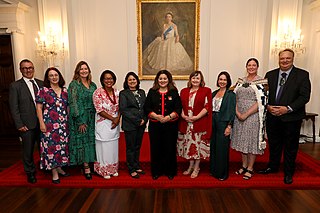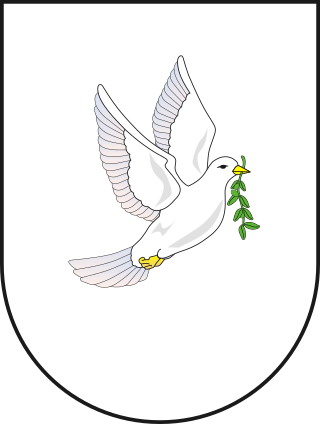
A viceroy is an official who reigns over a polity in the name of and as the representative of the monarch of the territory.

Upper Peru is a name for the land that was governed by the Real Audiencia of Charcas. The name originated in Buenos Aires towards the end of the 18th century after the Audiencia of Charcas was transferred from the Viceroyalty of Peru to the Viceroyalty of the Río de la Plata in 1776. It comprised the governorships of Potosí, La Paz, Cochabamba, Chiquitos, Moxos and Charcas.

The federative units of Brazil are subnational entities with a certain degree of autonomy and endowed with their own government and constitution, which together form the Federative Republic of Brazil. There are 26 states and one federal district. The states are generally based on historical, conventional borders which have developed over time. The states are divided into municipalities, while the Federal District assumes the competences of both a state and a municipality.

The Viceroyalty of Peru, officially known as the Kingdom of Peru, was a Spanish imperial provincial administrative district, created in 1542, that originally contained modern-day Peru and most of the Spanish Empire in South America, governed from the capital of Lima. Along with the Viceroyalty of New Spain, Peru was one of two Spanish viceroyalties in the Americas from the sixteenth to the eighteenth centuries.
Captain general is a high military rank of general officer grade, and a gubernatorial title.

The Viceroyalty of the Río de la Plata meaning "River of the Silver", also called "Viceroyalty of the River Plate" in some scholarly writings, in southern South America, was the last to be organized and also the shortest-lived of the Viceroyalties of the Spanish Empire in the Americas. The name "Provincias del Río de la Plata" was formally adopted in 1810 during the Cortes of Cádiz to designate the Viceroyalty of the Río de la Plata.
A Real Audience, or simply an Audience, was an appellate court in Spain and its empire. The name of the institution literally translates as Royal Audience. The additional designation chancillería was applied to the appellate courts in early modern Spain. Each audiencia had oidores.

The Spanish East Indies were the colonies of the Spanish Empire in Asia and Oceania from 1565 to 1901, governed through the captaincy general in Manila for the Spanish Crown, initially reporting to Mexico City, then Madrid, then later directly reporting to Madrid after the Spanish American Wars of Independence.

The Captaincy General of the Philippines was an administrative district of the Spanish Empire in Southeast Asia governed by a governor-general as a dependency of the Viceroyalty of New Spain based in Mexico City until Mexican independence when it was transferred directly to Madrid.

The First Treaty of San Ildefonso was signed on 1 October 1777 between Spain and Portugal. It settled long-running territorial disputes between the two kingdoms' possessions in South America, primarily in the Río de la Plata region.

The Captaincy General of Venezuela, was an administrative district of colonial Spain, created on September 8, 1777, through the Royal Decree of Graces of 1777, to provide more autonomy for the provinces of Venezuela, previously under the jurisdiction of the Audiencia of Santo Domingo and then the Viceroyalty of New Granada. It established a unified government in political (governorship), military, fiscal (intendancy), ecclesiastical (archdiocese) and judicial (audiencia) affairs. Its creation was part of the Bourbon Reforms and laid the groundwork for the future nation of Venezuela, in particular by orienting the province of Maracaibo towards the province of Caracas.

A captaincy is a historical administrative division of the former Spanish and Portuguese colonial empires. It was instituted as a method of organization, directly associated with the home-rule administrations of medieval feudal governments in which the monarch delimited territories for colonization that were administered by men of confidence.

The Provincias Internas, also known as the Comandancia y Capitanía General de las Provincias Internas, was an administrative district of the Spanish Empire created in 1776 to provide more autonomy for the frontier provinces of the Viceroyalty of New Spain, present-day northern Mexico and the Southwestern United States. The goal of its creation was to establish a unified government in political, military and fiscal affairs. Nevertheless, the Commandancy General experienced significant changes in its administration because of experimentation to find the best government for the frontier region as well as bureaucratic in-fighting. Its creation was part of the Bourbon Reforms and was part of an effort to invigorate economic and population growth in the region to stave off encroachment on the region by foreign powers. During its existence, the Commandancy General encompassed the provinces of Nueva Navarre, Nueva Vizcaya, Las Californias, Nuevo México, Nuevo Santander, Nuevo Reyno de León, Coahuila and Texas.

Guayana Province (1585−1864) was a former province of Spanish Colonial Venezuela and independent Venezuela, located in the Guyana region of northeastern South America.
The Captaincies of the Portuguese Empire were the socio-administrative territorial divisions and hereditary lordships established initially by Henry the Navigator, as part of the Donatário system in order to settle and developed the Portuguese overseas Empire. Pioneered on the island of Madeira and institutionalized in the archipelago of the Azores, the captaincy system was eventually adapted to the New World.

The Governorate General of Brazil was a colonial administration of the Portuguese Empire in present-day Brazil. A governorate was equivalent in status to a viceroyalty, though the title viceroy didn't come into use until the early 18th century. They were ruled by a Governor General who reported to the Crown. The Governor General had direct authority over the constituent royal captaincies, and nominal but ill-defined authority over the donatary captaincies. One captaincy, that of Duarte Coelho in Pernambuco, was exempt by royal decree from the authority of the Governors General.
Captaincies were military and administrative divisions in colonial Spanish America and the Spanish East Indies, established in areas under risk of foreign invasion or Indian attack. They could consist of just one province, or group several together. These captaincies general should be distinguished from the ones given to almost all of the conquistadores, which was based on an older tradition. During the Reconquista, the term "captain general" and similar ones had been used for the official in charge of all the troops in a given district. This office was transferred to America during the conquest and was usually granted along with the hereditary governorship to the adelantado in the patent issued by the Crown. This established a precedent that was recognized by the New Laws of 1542, but ultimately the crown eliminated all hereditary governorships in its overseas possessions.

The Captaincy of Bahia, fully the Captaincy of the Bay of All Saints, was a captaincy of Portuguese Brazil.










